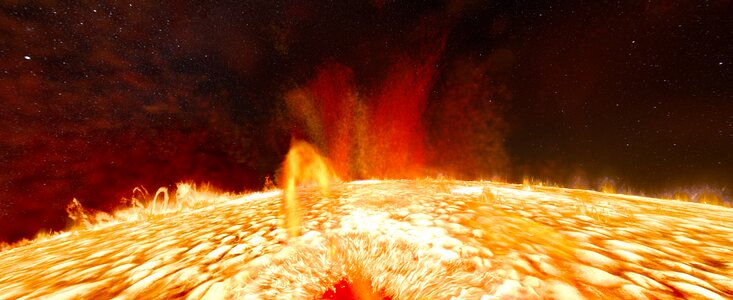es2406 — Organisation Release
Two planetarium shows added to the programme!
11 July 2024
For the summer holiday period, we are delighted to offer two new planetarium shows: Dynamic Earth and Solar Superstorms. Both films are available from Thursday 1 August and tickets can be booked online now.
If you are looking to escape the summer heat, or occasional rain, why not take the opportunity to enjoy one of the two new shows in our cool planetarium.
Solar Superstorms takes viewers into the tangle of magnetic fields and superhot plasma that vent the Sun's rage in dramatic flares, violent solar tornadoes, and the largest eruptions in the solar system, coronal mass ejections. The show features one of the most intensive efforts ever made to visualize the inner workings of the sun, including a series of groundbreaking scientific visualisations computed on the giant supercomputing initiative, Blue Waters, based at the National Center for Supercomputing Applications (NCSA), University of Illinois.
The planetarium show Dynamic Earth explores the inner workings of Earth’s great life support system: the global climate. Ride along on swirling ocean and wind currents, dive into the heart of a monster hurricane, come face-to-face with sharks and gigantic whales, and fly into roiling volcanoes. This cutting-edge production follows a trail of energy that flows from the Sun into the interlocking systems that shape our climate: the atmosphere, oceans, and the biosphere.
Each film lasts about 25 minutes and is accompanied by a live introduction by one of our presenters, also lasting approximately 25 minutes. Before each film, the current night sky is presented, indicating which constellations and other objects are visible in Germany. The live presentation also includes information about ESO's telescopes.
To watch a trailer for each film and book your tickets, please visit the show webpages:
Tickets cost 6,50 Euro each. Both shows are recommended for children age 11 years and up, but of course, younger children are also welcome to attend
More information
The ESO Supernova Planetarium & Visitor Centre
The ESO Supernova Planetarium & Visitor Centre is a cutting-edge astronomy centre for the public and an educational facility, located at the site of the ESO Headquarters in Garching bei München. The centre hosts a digital planetarium with a tilted, 360-degree dome, 14 metres in diameter, and an interactive exhibition, sharing the fascinating world of astronomy and ESO to inspire coming generations to appreciate and understand the Universe around us. All content is provided in English and German. Entrance to the exhibition is free. For planetarium shows, guided tours and other activities, visitors need to book and pay for their tickets online. For more details visit: supernova.eso.org
The ESO Supernova Planetarium & Visitor Centre is a cooperation between the European Southern Observatory (ESO) and the Heidelberg Institute for Theoretical Studies (HITS). The building is a donation from the Klaus Tschira Stiftung (KTS), a German foundation, and ESO runs the facility.
ESO Supernova is proudly supported by: LOR Foundation, Evans & Sutherland and Sky-Skan.
KTS
The Klaus Tschira Stiftung (KTS) was created in 1995 by the physicist and SAP co-founder Klaus Tschira (1940-2015). It is one of Europe’s largest privately funded non-profit foundations. The Foundation promotes the advancement of the natural sciences, mathematics, and computer science, and strives to raise appreciation for these fields. The Foundation’s commitment begins in kindergarten and continues in schools, universities, and research facilities. The Foundation champions new methods of scientific knowledge transfer, and supports both development and intelligible presentation of research findings.
HITS
The Heidelberg Institute for Theoretical Studies (HITS gGmbH) was established in 2010 by the physicist and SAP co-founder Klaus Tschira (1940-2015) and the Klaus Tschira Foundation as a private, non-profit research institute. HITS conducts basic research in the natural sciences, mathematics and computer science, with a focus on processing, structuring, and analysing large amounts of data. The research fields range from molecular biology to astrophysics. The shareholders of HITS are the HITS Stiftung, which is a subsidiary of the Klaus Tschira Foundation, Heidelberg University and the Karlsruhe Institute of Technology (KIT). HITS also cooperates with other universities and research institutes and with industrial partners. The base funding of HITS is provided by the HITS Stiftung with funds received from the Klaus Tschira Foundation. The primary external funding agencies are the Federal Ministry of Education and Research (BMBF), the German Research Foundation (DFG), and the European Union.
ESO
ESO is the foremost intergovernmental astronomy organisation in Europe and the world’s most productive ground-based astronomical observatory by far. It has 16 Member States: Austria, Belgium, the Czech Republic, Denmark, France, Finland, Germany, Ireland, Italy, the Netherlands, Poland, Portugal, Spain, Sweden, Switzerland and the United Kingdom, along with the host state of Chile and with Australia as a Strategic Partner. ESO carries out an ambitious programme focused on the design, construction and operation of powerful ground-based observing facilities enabling astronomers to make important scientific discoveries. ESO also plays a leading role in promoting and organising cooperation in astronomical research. ESO operates three unique world-class observing sites in Chile: La Silla, Paranal and Chajnantor. At Paranal, ESO operates the Very Large Telescope and its world-leading Very Large Telescope Interferometer as well as two survey telescopes, VISTA working in the infrared and the visible-light VLT Survey Telescope. Also at Paranal ESO will host and operate the Cherenkov Telescope Array South, the world’s largest and most sensitive gamma-ray observatory. ESO is also a major partner in two facilities on Chajnantor, APEX and ALMA, the largest astronomical project in existence. And on Cerro Armazones, close to Paranal, ESO is building the 39-metre Extremely Large Telescope, the ELT, which will become “the world’s biggest eye on the sky”.
Links
- ESO Supernova planetarium programme
- Plan your visit
- Donate to the ESO Supernova
- Subscribe to our newsletter
- Subscribe to our YouTube Channel
- Follow us on Instagram
Contacts
ESO Supernova Planetarium & Besucherzentrum
Garching b. München, Germany
Tel: +49 89 320 06 900
Email: supernova@eso.org

![Solarsuperstorms [Still 2]](/static/archives/images/thumbs/es1199_still2.jpg)